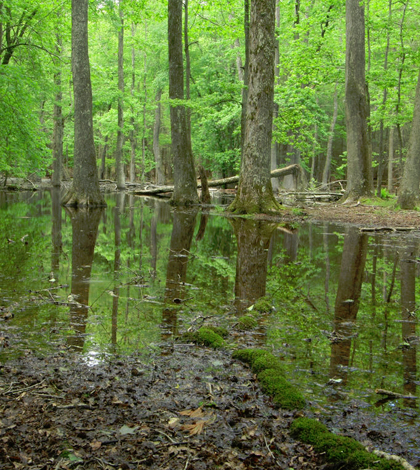Karst Wetlands At Risk From Climate Change In Southeast US

Gum Swamp, a karst-depression wetland in Great Smoky Mountain National Park, Tenn. (Credit: Alan Cressler / U.S. Geological Survey)
Researchers from the U.S. Geological Survey have completed a data synthesis charting part of the U.S. Southeast’s vulnerability to climate change. Their synthesis deems numerous insular ecosystems, from Virginia to Texas and up into the Great Plains, as threatened from predicted future changes.
Among those threatened are karst-depression wetlands, which occur throughout southeastern states from Virginia to Florida. The karst wetlands are highly sensitive to changes in precipitation and groundwater levels, authors found, noting that those are two things likely to change in the future.
Investigators completed a massive data synthesis to make the determination, bringing together existing literature on eight different categories of insular ecosystems of the region. Those also include granite outcrops of the Piedmont, limestone cedar glades, xeric limestone prairies, Mid-Appalachian shale barrens, high-elevation outcrops of the southern Appalachians, Carolina bays and river scour ecosystems.
The regional synthesis was undertaken to discern patterns across ecosystems, identify knowledge gaps and lay the groundwork for future analyses of climate-change vulnerability. Findings indicate that insular ecosystems of the southeastern United States have already been subjected to a variety of direct and indirect human alterations despite their importance to regional and global biodiversity.
Investigators believe that more scientific study is needed to quantify the links between changing conditions and ecological processes that sustain biodiversity in the region. Many important questions remain, authors write, concerning how these ecosystems function.
Before the large-scale synthesis, data on the ecosystems’ vulnerability were generally fragmented. By bringing them together, scientists looked to form a clearer picture of what may be in store. In addition, the results of the synthesis may help to preserve the ecosystems in the future.
Full results of the synthesis are published in the U.S. Geological Survey’s Publications Warehouse. A direct link to the report, including much more precise information on each insular ecosystem threatened, can be found here.
Top image: Gum Swamp, a karst-depression wetland in Great Smoky Mountain National Park, Tenn. (Credit: Alan Cressler / U.S. Geological Survey)





0 comments